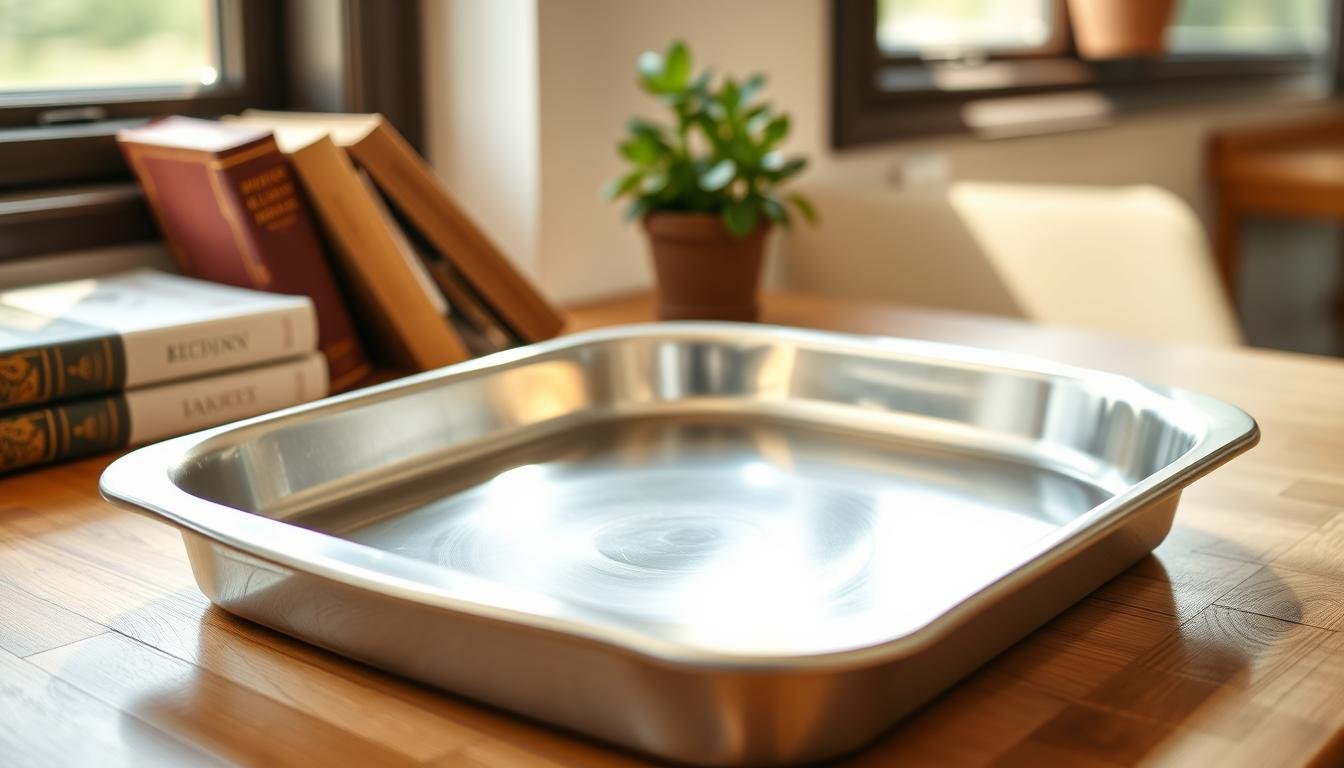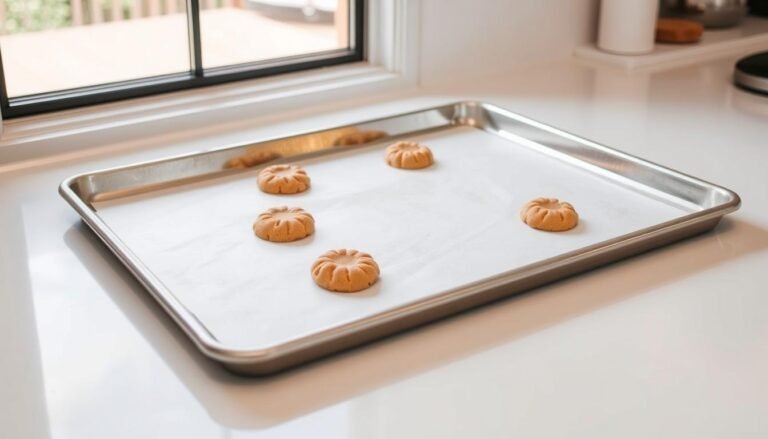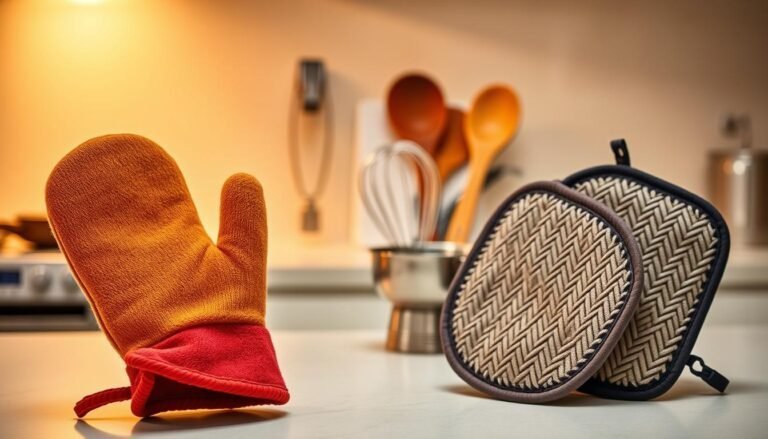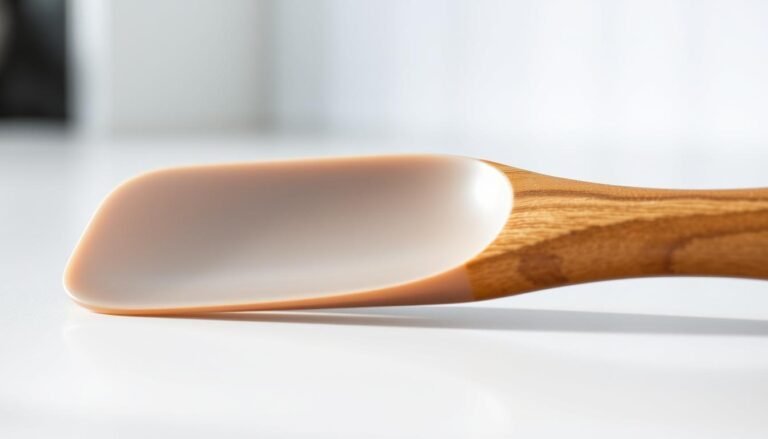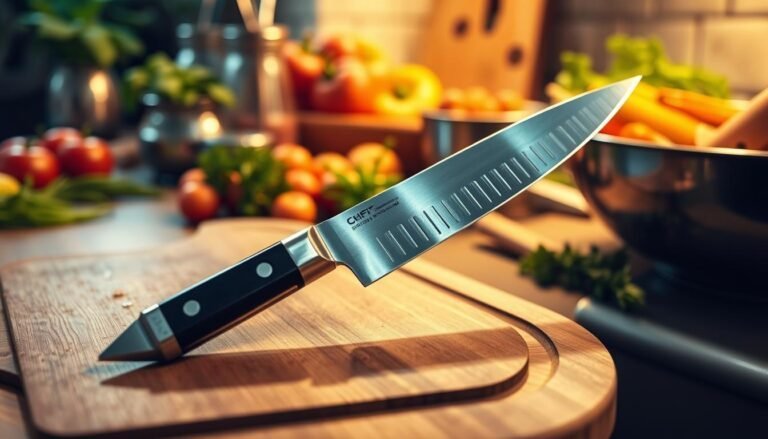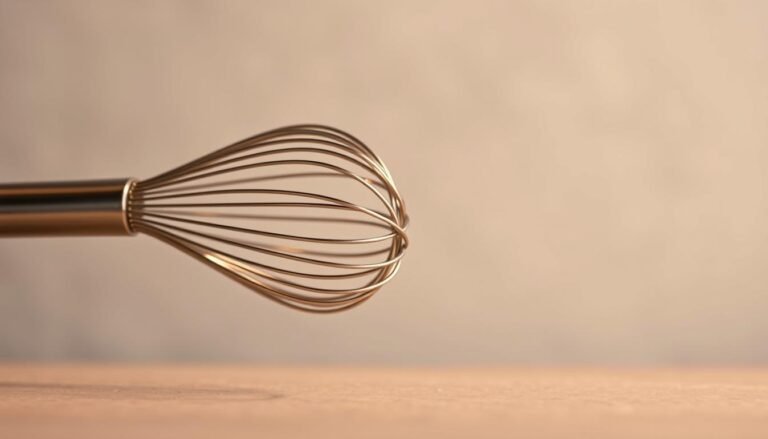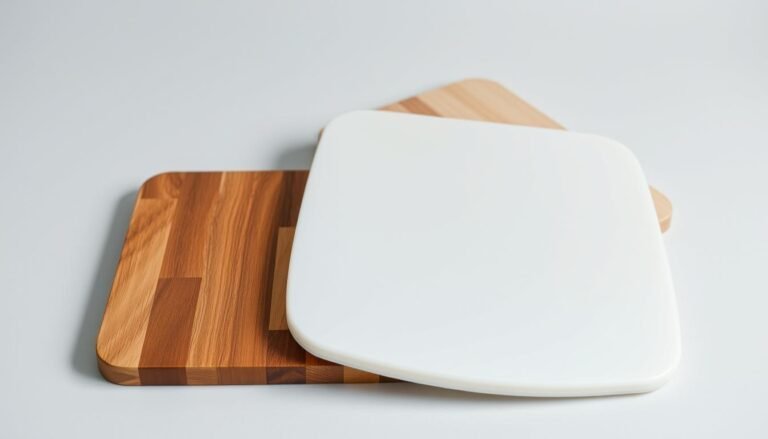Disclosure: This Post Contains Affiliate Links; We earn a commission on purchases.
Baking the perfect layer cake needs careful attention. Choosing the right baking pan is key. The pan type greatly affects the cake’s texture, browning, and structure.
The Nordic Ware Natural Aluminum Commercial Round Layer Cake Pan is a top pick. Its aluminum construction ensures even heat. This leads to perfectly baked layers. For more tips, check out our guide on 5 tips for perfect cake layers.
Key Takeaways
- Choose a pan that allows for even heat distribution.
- Consider the material and construction of the pan.
- Straight-sided pans help achieve cakes with straight sides.
- Taller pans support the cake as it rises.
- Anodized aluminum pans are a great option for baking perfect layers.
Understanding Different Cake Pan Materials
Different cake pan materials have their own benefits and drawbacks. They can change how your cake turns out. The material affects baking time, cake texture, and how easy it is to get the cake out.
Aluminum Cake Pans: The Professional’s Choice
Aluminum pans are a top pick for pros. They conduct heat well, leading to even baking and browning. Aluminum cake pans are great for making delicate cakes and pastries.
Light vs. Dark Aluminum and Heat Conductivity
The color of the aluminum pan matters. Dark pans soak up heat, which can cause over-browning. Light pans bounce heat back, helping cakes bake evenly.
Silicone Cake Pans: Flexibility and Easy Release
Silicone cake pans are flexible and non-stick. This makes it easy to get the cake out. They’re perfect for fancy cake designs and sweet treats.
When to Choose Silicone Over Traditional Materials
Go for silicone pans for cakes that need easy release. They’re also dishwasher safe, making cleaning up a breeze.
Glass, Ceramic, and Steel Options: Pros and Cons
Glass pans spread heat evenly but are heavy and can break easily. Ceramic pans are pretty and safe but need more care. Steel pans are strong but can bend if heated too high.
Knowing what each material does helps bakers pick the best pan. This way, they can get pro results at home.
Selecting the Ideal Cake Pan Size and Shape
Choosing the right cake pan size and shape is key for great cakes. The right pan can greatly affect your baked goods. This is true for simple cakes or complex multi-layer desserts.
Standard Round Cake Pan Dimensions for Layer Cakes
Round cake pans are best for layer cakes. Sizes like 6-inch, 8-inch, and 9-inch are common. These pans work well for many recipes. Think about how many layers you want and the cake’s final size when picking a pan.
Matching Pan Size to Recipe Requirements
It’s important to match your pan size to your recipe. A pan that’s too small can make the cake too thick and uneven. A pan that’s too big can make the cake too thin and overcooked. For help with pan sizes and recipes, check out cake pan size guides.
Square and Rectangular Pans: Practical Applications
Square cake pans and rectangular pans are great for certain cakes and desserts. They’re perfect for recipes that need a different look or texture than round cakes. Keep in mind that these pans can change baking time and texture.
Specialty Shapes: When to Use Bundt, Loaf, and Sheet Pans
Specialty pans like Bundt pans, loaf pans, and sheet pans have special uses. Bundt pans make decorative ring-shaped cakes. Loaf pans are best for bread or pound cake. Sheet pans are versatile for many recipes, from cookies to large desserts. Choose a specialty pan based on your recipe’s needs and desired result.
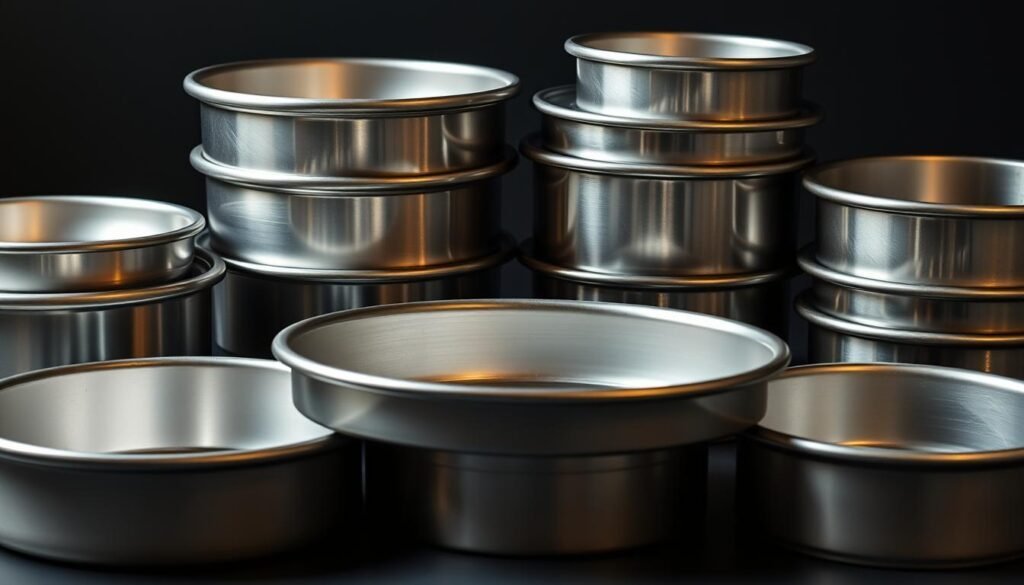
Essential Cake Pan Features for Professional Results
To get perfect cakes, knowing what makes a good cake pan is key. The right pan can greatly improve your baked goods.
Non-Stick Coatings: Benefits and Limitations
Non-stick coatings make food easy to remove from pans. But, they can wear out and might be harmful if too hot. High-quality non-stick coatings work well, but always follow the maker’s advice.
Removable Bottoms and Springform Designs
Cake pans with removable bottoms or springform designs are great for delicate cakes. They make easy cake release possible without harming the cake. Springform pans are best for cheesecakes and tortes.
Edge Design: Straight vs. Sloped Sides
The edge of a cake pan is important for baking and stacking. Straight-sided pans are best for layer cakes because they stack flat. Sloped sides are easier for cake release but harder for stacking.
How Edge Design Affects Layer Stacking
The edge design of a cake pan affects layer stacking. Straight edges make stacking easy and even. Sloped edges need extra steps, like leveling or using a cake ring.
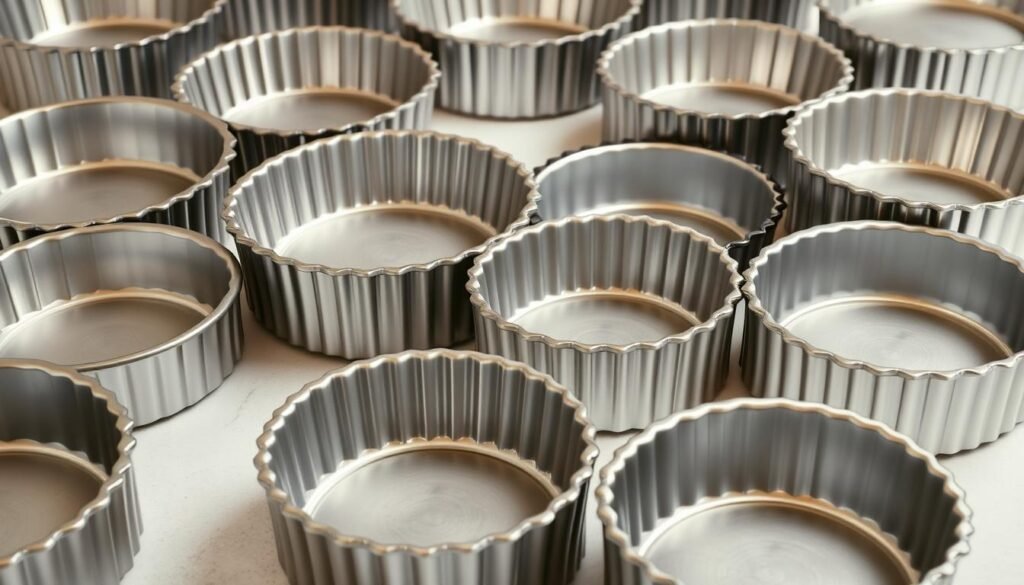
How to Evaluate Cake Pan Quality Before Purchasing
Checking a cake pan’s quality before buying is key for top baking results. A good cake pan spreads heat evenly, lasts long, and is easy to use.
Weight and Thickness Considerations
The weight and thickness of a cake pan matter a lot. A thin pan might warp in the oven, causing cakes to cook unevenly. Choose pans that are at least 1.5 mm thick to keep their shape under heat.
A heavier pan usually means it’s better made and will bake more evenly.
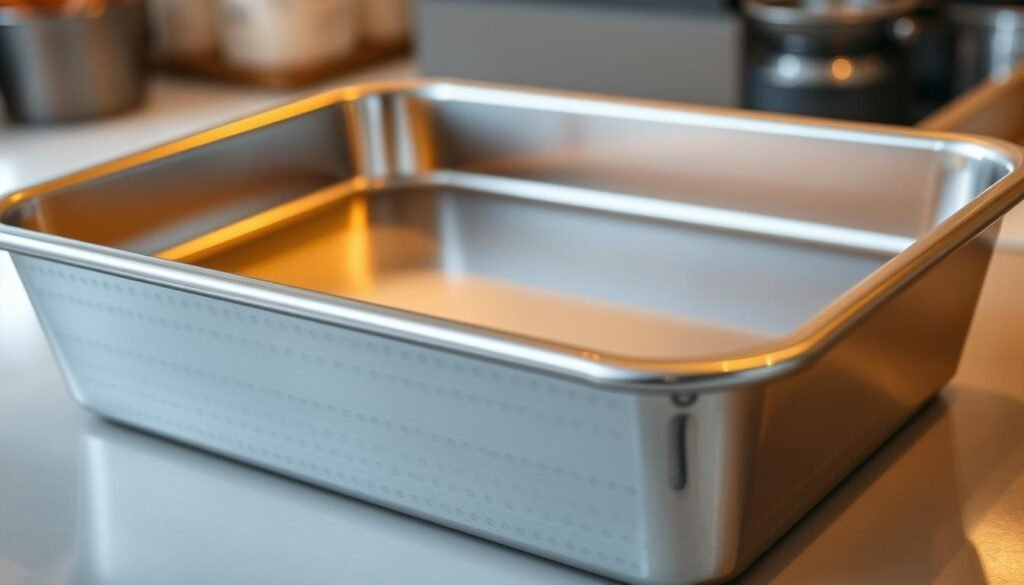
Examining Construction and Durability Features
The build and durability of a cake pan are key for lasting use and good results. Non-stick coatings help cakes come out easily, but how long they last varies by brand.
- Look for strong handles that won’t break off.
- Make sure the pan’s material can resist corrosion and scratches.
- Choose pans with reinforced bottoms for extra toughness.
Best Cake Pan Brands and Price Points
Some brands are known for their high-quality pans. Calphalon, All-Clad, and Anolon make top-notch pans, but they cost more.
Budget-Friendly vs. Professional-Grade Options
While top-tier pans are the best, cheaper options can work well for casual bakers. Wilton and Chicago Metallic make affordable pans good for home use.
- Budget-friendly options: $10-$30
- Mid-range: $30-$60
- Professional-grade: $60-$100+
Conclusion: Selecting the Best Cake Pan for Your Baking Needs
Choosing the right cake pan is key for perfect layers every time. The type of cake, material, size, and features matter a lot. They all affect how your baked goods turn out.
When selecting the best cake pan, think about the material. You can choose from aluminum, silicone, glass, ceramic, or steel. Each has its own good points and bad points. The right choice depends on what you need for baking.
The size and shape of the cake pan are also very important. They impact how your cake layers and looks. Features like non-stick coatings, removable bottoms, and springform designs can also help your cake pan work better.
By looking at these factors and picking a top-quality cake pan or baking pan, you can bake successfully. You’ll make beautiful cakes. The right cake pan can really change your baking. Knowing your options and picking the best one can help you bake like a pro.
FAQ
What is the best material for a cake pan?
What are the benefits of using a non-stick cake pan?
How do I choose the right size cake pan for my recipe?
What are the advantages of using a silicone cake pan?
How important is the edge design of a cake pan?
What should I consider when evaluating the quality of a cake pan?
Are budget-friendly cake pans worth considering?
Can I use a glass or ceramic cake pan for layer cakes?
What are the benefits of a removable bottom or springform cake pan?
How do I care for and maintain my cake pans?

From beginner-friendly tips to no-fuss dessert ideas, Ryan is all about helping people enjoy baking and treat-making without the stress. Whether you’re whipping up something for a party or just craving something sweet, Ryan’s practical approach makes it easy to create desserts that taste great and don’t take all day.
Subscribe to Our Newsletter

